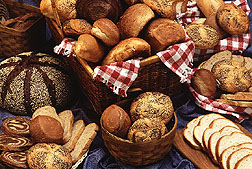 Image Number K7251-27 |
Leavened bread has been around a long while-since the days of ancient Egypt, Babylon and Greece, in fact. Then, as now, it was made from wheat, or from a mixture of wheat and rye. The elastic gluten in wheat is essential for bread to rise.
But a lot has changed-today's bread is mass-produced. Brews of yeast, made in huge vats, are mixed continuously with flour, water, and other ingredients at one end of a machine. At the other end, dough is squished out of a tube, shaped, and cut automatically into loaves. The loaves drop into pans, rise, and are baked at the rate of thousands an hour.
Our bread also contains more ingredients and additives, which causes special problems for the baker, miller, and farmer. Even the same classes of wheat can vary significantly in baking qualities. And when these differences are great enough, they can cause a lot of trouble in a bread factory!
For 50 years, ARS laboratories have worked with all segments of the industry to help provide consumers with uniform, flavorful, nutritious bread and other wheat products. They identified and isolated wheat proteins not previously known to exist. They showed that these proteins-gliadin and glutenin-contain a specific chemical structure that affects mixing properties of flours in forming doughs. They discovered the role of fatlike constituents in flour in controlling volume of bread and size of cookies. They found that certain water-soluble proteins called albumins are as essential as gluten in producing a good loaf of bread.
And, over the years, ARS technologists baked thousands of loaves of bread to test different flours and to determine the effects of new additives.
Busy though scientists have been, research is accelerating. Today, with a sample no larger than half a kernel, a chemist can analyze a type of gluten protein and determine its baking properties. This can help wheat breeders get an early indication of the kind of flour their most promising plants will produce. "It provides us with an incredible amount of information," says one researcher. "And it gives it to us in a day instead of in months or years."
Other scientists work with glutenin, the other important protein in wheat gluten. Not all glutenins, it turns out, are created equal. A team of chemists is exploring the structure of glutenins of assorted molecular weights, shapes, and sizes. The research could help in the genetic engineering of glutenins that can outperform those of today.
Photo by Scott Bauer.

